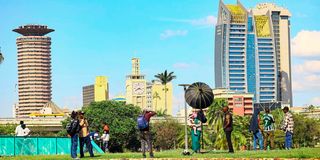How greening urban spaces will boost Africa’s resilience against climate change

Uhuru Park, which was recently renovated.
What you need to know:
- Urban greening is the integration of natural elements like parks, trees, green roofs, wetlands, and urban forests into city landscapes.
Africa’s urban areas, home to over half a billion people today and projected to accommodate nearly a billion more by 2050, are expanding at an unprecedented rate. However, this rapid urbanisation, while a sign of economic dynamism and opportunities, comes with escalating climate risks. Recent research indicates that about 70 per cent of African cities face threats from flooding, heatwaves, drought, and storms. Without intervention, these hazards could cripple infrastructure, strain public health systems, and hinder economic growth.
The effects are already visible. In coastal cities, rising sea levels and intense rainfall have led to devastating floods, displacing families and disrupting livelihoods. In landlocked capitals, the "urban heat island" effect, where concrete and asphalt trap heat, has made daily life increasingly unbearable, particularly for the most vulnerable.
Without urgent action, these impacts will only put millions more at risk. Floods will destroy homes and infrastructure, heatwaves will worsen health outcomes, and food and water insecurity will rise. The economic costs will be staggering, and the social fabric of cities could fray under the strain.
But there is hope. Under the Paris Agreement, every African nation has submitted Nationally Determined Contributions (NDCs), climate action plans that set out how to reduce emissions and adapt to climate change. Increasingly, experts and policymakers agree that nature-based solutions, including urban greening, must be at the heart of these plans.
What is urban greening?
Urban greening is the integration of natural elements like parks, trees, green roofs, wetlands, and urban forests into city landscapes. Beyond beautifying cities, this is a science-backed approach to managing stormwater, reducing urban temperatures, improving air quality, and boosting public health and well-being.
For example, planting trees along streets provides shade, cools the air, and absorbs carbon dioxide. Creating wetlands near neighbourhoods helps absorb excess rainwater and prevent floods. Green roofs and walls insulate buildings, lowering energy costs and reducing the "heat island" effect.
Developed countries have executed urban greening for years. In Basel, Switzerland, and Hamburg, Germany, green roofs are an urban landscape standard, demonstrating how green infrastructure can make a tangible difference in resilience and quality of life with the right policies and investments.
Also read: Greening transport one tuk tuk at a time
In Africa, the movement is gaining momentum, albeit slowly. Some cities have integrated urban forests into city planning, providing shade and improving air quality. Others are restoring green spaces to reduce flooding and create recreational areas, while some have launched projects ranging from green pavements to urban agriculture, each a step toward a more resilient urban future.
The benefits of urban greening are profound and wide-ranging. Environmentally, green spaces help cities adapt to climate change by moderating temperatures, absorbing floodwaters, and filtering pollutants from the air. Socially, access to parks and trees improves mental and physical health, reduces stress, and fosters community bonds. Economically, green infrastructure can lower energy bills, create jobs in landscaping and maintenance, and boost property values.
For Africa's coastal cities, greening is especially critical. Restoring mangroves and coastal forests provides natural barriers against storm surges and rising seas. In landlocked cities, urban forests and gardens offer respite from heat and improve food security.
While developed cities have made significant strides, often supported by robust policy frameworks and funding, African cities face unique challenges. Only 15 African countries have implemented nature-based solutions as part of their climate adaptation strategies, and most projects remain concentrated in rural areas. Urban planning often overlooks green infrastructure, and governments rarely seek enough private sector investment to scale up these initiatives.
There's also a shortage of evidence-based strategies and local knowledge for successful implementation. Many city officials lack training in setting up and managing nature-based solutions, and there is insufficient collaboration between governments, planners, and communities. Technical expertise is in short supply as few city planners and officials have the training to design, implement, and maintain adequate green infrastructure, while community engagement is often lacking. A shortage of locally relevant data to guide and justify investment slows urban greening.
Rapid urbanisation adds to the complexity. As cities race to accommodate the growing population, green spaces are often sacrificed for quick, concrete-heavy development. This leads to deforestation, land degradation, and the loss of vital ecosystem services when needed to help cities adapt to climate change.
To unlock the full potential of urban greening, African countries must integrate nature-based solutions into their urban development strategies and NDCs. This means investing in training for city officials, strengthening policy frameworks, and fostering partnerships between governments, the private sector, and local communities. The International Union for Conservation of Nature has developed global standards to help countries scale up these projects, emphasising cost-effectiveness, replicability, and the need for both public and private investment.

